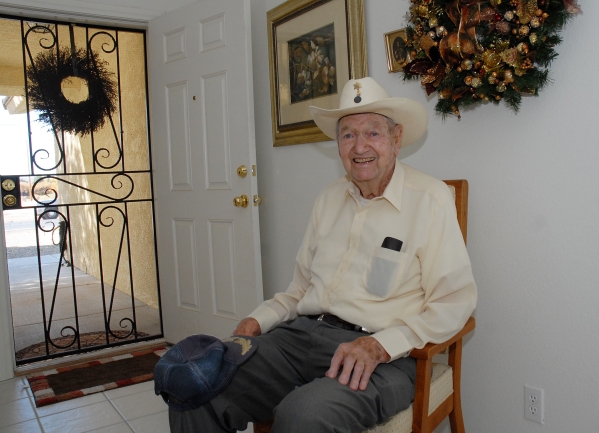
The Pahrump Valley has long experienced mild winters. But for thousands of years, the only people who knew about it were the local Native Americans.
That was all going to change when Elmer Bowman purchased the huge Manse Ranch in 1946 and Walt Williams bought the giant Pahrump Ranch in 1957. We can date the beginnings of modern Pahrump and a much wider appreciation of the valley’s mild winters to those events.
In 1970 Leonard Rosen, through his Preferred Equities company, acquired the 10,000-acre Pahrump Ranch from Williams.
Rosen had first visited Las Vegas in 1950 and never forgot the desert. He had always wanted to build an ideal community and he believed Pahrump was the place to do it. Preferred Equities immediately set about developing the ranch. Large numbers of lots were laid out, streets constructed, and a sales force put to work.
A new Pahrump was on its way to its future as smaller ranches also began subdividing their holdings.
One of the things Preferred Equities did early on was to construct a recreational vehicle park and build a golf course. This would serve two functions. One, it would provide owners of RVs who might be passing through the area with space to park their vehicles and stay a few nights or perhaps longer. While there, a sales staff could attempt to interest the visitors in purchasing an RV parking spot or perhaps a lot in one of the company’s subdivisions, either as an investment or as a place to build a home.
All this led to Pahrump becoming a destination for “snowbirds,” typically people from colder parts of the country, often retired, who take up residence in a warmer climate from November through April.
Oakley Porter Discovers Pahrump
Porter is one snowbird who quickly acquired a strong affinity for Pahrump. He was born in 1925 in Alturas, California, located about 30 miles from the Nevada and Oregon borders, and grew up on a nearby ranch.
Not long out of school, he read in the Sacramento Bee of opportunities to go overseas as an airline mechanic working for United Airlines. He hired on at United and, after he had worked for a while as a mechanic, the airline asked him if he would like to become a flight engineer. He jumped at the chance, becoming a flight engineer on a DC6 in the early 1950s.
Then the company asked him if he would like to be a co-pilot. Again, he jumped at that opportunity, starting out on DC8s, then DC10s.
Then he went back to flight engineer on 747s, then to piloting the big 747s around the world, on which he logged 7,000 hours out of a total of 33,000 hours flying for United Airlines. Amazingly, for much of this time he continued to reside in Alturas, commuting to work in San Francisco in his own two-engine Cessna.
Porter was required to retire from United Airlines in 1985 at the age of 60. Though he still owned a big ranch near Alturas (20,000 acres and 3,000 cattle, managed by his children), he and his wife had it in their minds to become snowbirds. They purchased a big Silver Eagle bus and converted it into a motorhome. For the next couple of years they made their way down to Yuma, Arizona, for the winters.
After a couple of years, they decided to check out Death Valley on the way to Yuma. At Scotty’s Castle, they called over to Pahrump’s Preferred Equities RV Resort to see if the resort had a spot where they could park their motor home for a couple of days.
“Yes, come on over,” was the reply. In Pahrump they were invited to purchase a membership in the resort, which included “free golf course for both, and some dinners.” They joined, but continued on to Yuma. The next year, they skipped Yuma and spent the season in Pahrump. Thereafter, Pahrump became their home from November through April.
Living in Pahrump
Porter recalls that at the time there were about 150 RV parking spots at the park, far fewer than the current number now in Pahrump. Snowbirds, like the locals, did the majority of their shopping in Las Vegas in those years. In Pahrump, he says, there was Floyd’s Hardware and Dodge’s Market, which were small. There was no Smith’s or Wal-Mart. As a guess, Porter estimates there were perhaps 300 snowbirds at that time in Pahrump. Now there are many times that number, he says.
He estimated there were 8,000 people in Pahrump at the time. Many of the “old-timers,” he says, are still here.
Playing golf on the golf course was a great joy for Porter and many of the snowbirds in Pahrump. He took up making golf clubs for Pahrump golfers as well as Las Vegas residents. He crafted them to the buyer’s specifications – $900 to $1,000 for a set of four woods and nine irons. Porter says, with a gleam in his eye, “I love to play golf in Pahrump eight days a week.”
Over the years, Porter formed many friendships with both snowbirds and permanent Pahrump residents. After living in the motor home for a number of winters, in 1994 he and his wife purchased a lot and built a home in Pahrump. They lived in it for several years but, missing the good friends who lived in the park, they sold it and moved back into the motor home. Later, they bought a different home and moved into it.
The snowbirds, with their love of Pahrump and its possibilities for high-quality living, have been an important part of the community’s growth and vitality over the past 40 years.
Bob McCracken has a doctorate in cultural anthropology and is the author of numerous books in the Nye County Town History Project, including a history of Pahrump.